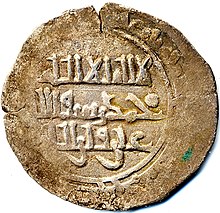
Back نصر بن صالح آل مرداس Arabic Nəsir Şibl əd-Dəvlə Azerbaijani نصر بن صالح مرداس AZB Nasr ibn Sàlih Catalan نصر بن صالح بن مرداس Persian Abu Kamil Nasr ibn Salih ibn Mirdas French Şibhüddevle Ebû Kâmil Nasr Turkish
| Nasr ibn Salih | |||||||||
|---|---|---|---|---|---|---|---|---|---|
 A silver dirham of Nasr ibn Salih, minted in Aleppo in 1033/34 | |||||||||
| Emir of Aleppo | |||||||||
| Reign | May 1029 – 22 May 1038 (jointly with Thimal ibn Salih in May 1029 – mid-1030) | ||||||||
| Predecessor | Salih ibn Mirdas | ||||||||
| Successor | Thimal ibn Salih | ||||||||
| Died | 22 May 1038 Tell Fas (near Latmin) | ||||||||
| Spouse | Al-Sayyida Alawiyya bint Waththab | ||||||||
| Issue | Mahmud | ||||||||
| |||||||||
| Tribe | Banu Kilab | ||||||||
| Dynasty | Mirdasid | ||||||||
| Father | Salih ibn Mirdas | ||||||||
| Religion | Shia Islam | ||||||||
Abu Kamil Nasr ibn Salih ibn Mirdas (Arabic: نصر بن صالح بن مرداس, romanized: Abū Kāmil Naṣr ibn Ṣāliḥ ibn Mirdās) (died 22 May 1038), also known by his laqab (honorific epithet) of Shibl al-Dawla ('Lion cub of the Dynasty'), was the second Mirdasid emir of Aleppo, ruling between May 1029 until his death. He was the eldest son of Salih ibn Mirdas, founder of the Mirdasid dynasty. Nasr fought alongside his father in the Battle of al-Uqhuwana near Tiberias in 1029, where Salih was killed by a Fatimid army led by Anushtakin al-Dizbari. Afterward, Nasr ruled the emirate jointly with his brother Thimal. The young emirs soon after faced a large-scale Byzantine offensive led by Emperor Romanos III. Commanding a much smaller force of Bedouin horsemen, Nasr routed the Byzantines at the Battle of Azaz in 1030.
After his victory, Nasr ousted Thimal from Aleppo and entered into Byzantine vassalage, while maintaining ties with the Fatimids. He nominally recognized Fatimid suzerainty in 1037 and was concurrently given control of Hims, which the Mirdasids had lost to the Fatimids several years prior. Anushtakin, who had become governor of Syria, objected to Nasr's acquisition of Hims. In 1038, his forces marched against Nasr and killed him in a battle in the environs of Hama. Nasr was succeeded by Thimal, but Aleppo fell to Anushtakin weeks later. Mirdasid rule was restored in 1042 and continued with some interruptions until 1080.
Nasr renovated the Aleppo Citadel and made it his seat of power. Under the direction of his local Christian vizier, al-Mu'ammal al-Shammas, Aleppo was expanded and urbanized to accommodate an influx of Muslims from the countryside. Nasr's rule was limited to the northern Syrian part of the emirate, while the Mirdasids' Upper Mesopotamian fortresses were controlled by Thimal. His relations with his own tribe, the Banu Kilab, were often strained, but Nasr secured strong ties with the powerful Banu Numayr by marrying the Numayrid princess al-Sayyida Alawiyya. With her, he had a son, Mahmud, who ruled Aleppo in 1065–1075.
© MMXXIII Rich X Search. We shall prevail. All rights reserved. Rich X Search